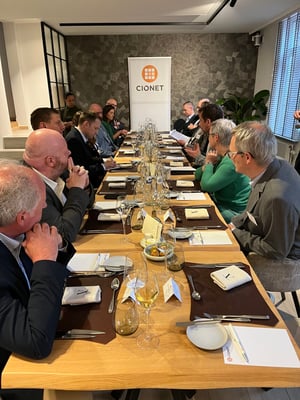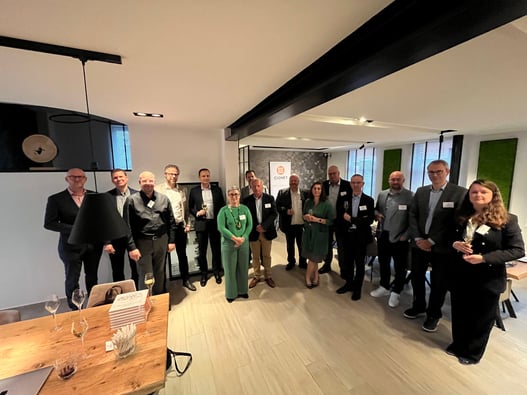-1.png)
As soon as an organisation wants to embark on its strategic digital transformation, the crucial question arises: "Who should shape this change process, who will 'field' it? Will you consult third parties for this, or can you find or create the right competencies internally?" We asked Michal Paprocki, Group CIO of Euroclear, during the roundtable organised by CIONET in collaboration with INNOCOM on May 8. His testimony was "spot on" and a source of inspiration for the eleven other digital leaders at the table.

Euroclear has opted for a strategic course change.
Euroclear's business model originated 50 years ago. The organisation has since become a solid presence in the world of securities, boasting an exemplary track record and embodying trust and steadfastness. A perfect story indeed but also a situation that entails a rather conservative attitude under the motto “don’t change a winning horse”. At the same time, significant disruption is taking place in the financial world: new regulations, evolving customer expectations and emerging technologies such as blockchain. All these elements give rise to new business models. Moreover, Euroclear possesses a wealth of data from which highly valuable insights can be derived for their customers. In this context, Euroclear has chosen to forge ahead with a customer-centric growth strategy based on creating new intelligent data-based services with added value. All of this requires new digital capabilities, an agile and data-driven corporate culture and organisation, but above all, engagement and employees who are willing to challenge the status quo.
 Given that it is a digital transformation, it is almost obvious to look at the IT teams, particularly the Enterprise Architects. This team of around 50 people already holds a special position at Euroclear. They bridge the gap between IT and business and ensure that the business strategy is translated into an IT strategy and that the IT architecture aligns with the business objectives. Precisely because of this business proximity, Michal explicitly chose to have these new capabilities as much as possible in-house. The question then remained how to determine whether the existing team possesses the right skills and mindset and how to teach them the missing skills to fulfil their crucial role as change agents. The answer apparently lay, to some extent, in the collaboration with partners and consultants—such as INNOCOM—with whom a program was developed in multiple cycles to facilitate knowledge transfer and build up competencies, both the hard (technological) skills and the so-called soft skills (including people management), and to enhance the effectiveness of the entire team
Given that it is a digital transformation, it is almost obvious to look at the IT teams, particularly the Enterprise Architects. This team of around 50 people already holds a special position at Euroclear. They bridge the gap between IT and business and ensure that the business strategy is translated into an IT strategy and that the IT architecture aligns with the business objectives. Precisely because of this business proximity, Michal explicitly chose to have these new capabilities as much as possible in-house. The question then remained how to determine whether the existing team possesses the right skills and mindset and how to teach them the missing skills to fulfil their crucial role as change agents. The answer apparently lay, to some extent, in the collaboration with partners and consultants—such as INNOCOM—with whom a program was developed in multiple cycles to facilitate knowledge transfer and build up competencies, both the hard (technological) skills and the so-called soft skills (including people management), and to enhance the effectiveness of the entire team
Tom Hendrickx, Enterprise Architect & Transformation Manager at INNOCOM, explains this programme: "We work on four levels: skills, knowledge, intimacy, and, finally, attitude. The latter strongly focuses on the purpose, the internalisation of the objective: not only must the reasons for the changes be very clear, but the individual must also understand how their role fits into the plan and ideally personally embrace the goal. At that moment, they become an active ambassador of the change programme."
"The old school of IT and Enterprise architects does not fit into this program," Michal confirms. "The new architect is close to the business and is the driving force behind the transition. In fact, the entire IT team now has to co-create the service portfolio of Euroclear in an agile manner, together with their business colleagues."
Should you look externally or focus on internal re-skilling programs?
The roundtable discussion clearly indicated that many CIOs recognised themselves in Euroclear's challenge but that the solution to the skills problem fundamentally differs from one company to another.
“At Gaming One”, according to Steve Caulier, Delivery director, “we are working on the new platform from a versatile organisation in 26 countries simultaneously, from specific domains. People are thinking not in terms of products but in terms of experiences and value. The driving force behind this approach is a coalition of the willing, a group that acts as ambassadors and takes the rest of the organisation - including the business - in tow”.
Celia Galeotti, Head of Technology Platform Office at SWIFT, is going through the same transition at SWIFT which is transforming from a provider of technology to a provider of a platform of value-added services. Moreover, SWIFT is launching new services - at the request of its customers - such as low value payments. The blueprint for this transition was developed in collaboration with external consultants. Implementation will be ensured by a mix of external resources and internally driven training. "Given the tensions in the IT labour market, it is anyway an illusion to think that you will be able to recruit the people with the right skills," Celia adds. "So, bring in external expertise, and ensure sufficient knowledge transfer to your own people."
"We are a rather smaller, niche player in the banking landscape," explains Jan Vanderhallen, ICT Director at the Bank of Breda, "And pursue a somewhat idiosyncratic IT personnel policy. We try to meet all our skills needs through internal training and coaching. Although we recruit young school leavers, we deliberately and very selectively look for the high potentials, whom we then train and coach very intensively. So far, we have always succeeded in meeting our needs in this way."

The best of both worlds
NBN, the institute for standardisation in Belgium, is the organisation that makes the (ISO and other) standards available to companies and organisations in this country. "Our strategy is simple" says Yvan Baes, IT manager at NBN, "Everything that is product- and business ownership-related is done in-house. Everything else is 100% outsourced. We are also going through a digital transformation, making maximum use of partners and cloud services." The approach of the Port of Antwerp - Bruges is similarly focused on consolidating the necessary skills internally for all and structural and company-specific functions, while for temporary and generic assignments, "externals are called upon", agrees Peter Tordeur, HR Business Architect & Sr Program Manager at the port authority.
Gitana Vaiciulyte, Transformation Programme Manager at Terumo Europe fully recognises the dilemma: "Terumo's digital transformation is a crucial programme, a must to remain competitive in the market. Consequently, having the necessary digital competences in-house becomes a must. As we work in a highly regularised context, the business is easily reluctant to all 'agile' initiatives, in part from the fear of making 'compliance' mistakes."
Act as one
The crucial point in any story anyway is the need for an intense collaboration between business and IT. The discussion often turns to responsibility. IT can shape the digital transformation, but the business has to join the bath, and has to (co)decide. The "enterprise architect" can wear many hats, and hold other titles, but in the end, he or she is someone who can make the perfect translation of business into IT ... and vice versa, and who has the necessary credibility beyond to inspire the entire organisation. And in case the necessary skills are impossible to find in individuals, make sure you create a diverse team that aggregates all these competencies and acts as one to lead the change.
Special thanks to Michal Paprocki, our guest speaker for the evening and to all participants for their enthusiastic contribution to this roundtable discussion:
--
These Stories on CIONET Belgium
No Comments Yet
Let us know what you think